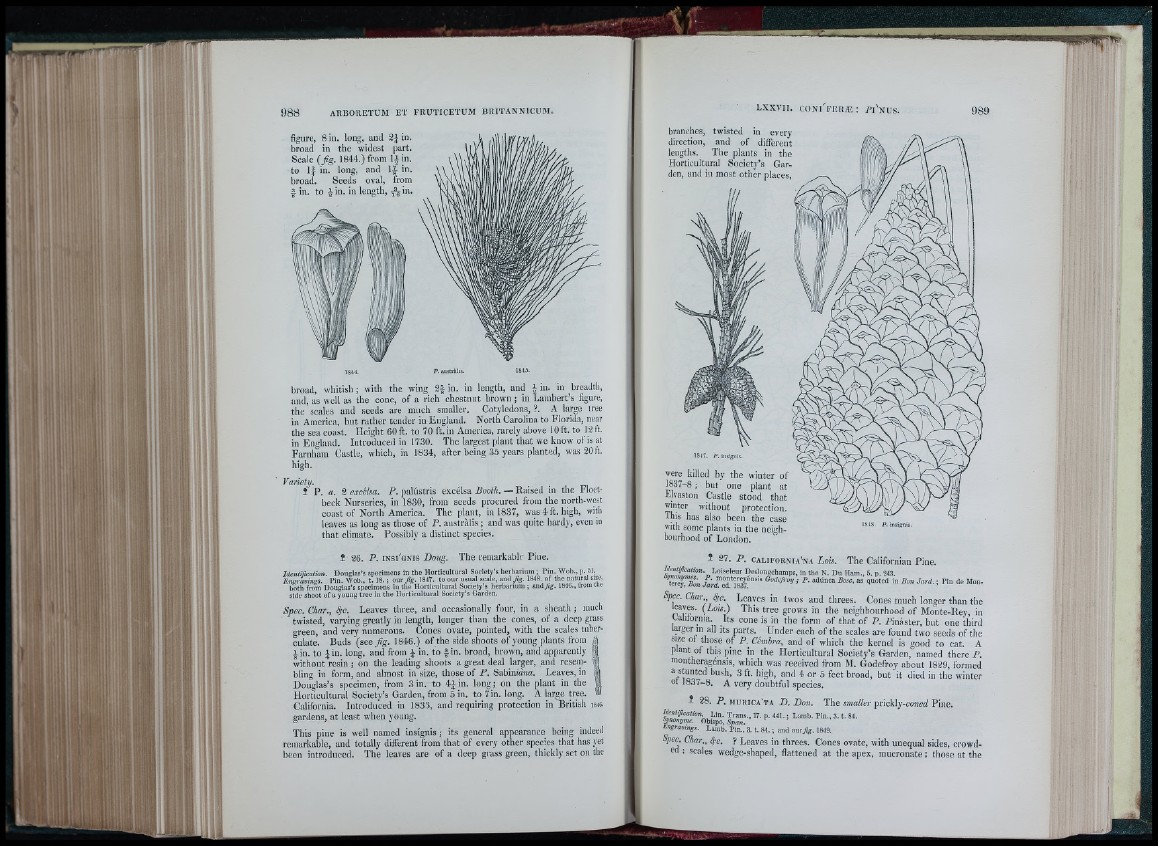
figure, 8 in. long, and 2 ^ in.
broad in the widest part.
Scale (fig . 1844.) from liin .
to 1 | in. long, and 1 |- in.
broad. Seeds oval, from
broad, whitish; with the wing 2 | in. in length, and i in. in breadtli,
and, as well as the cone, of a rich chestnut brown ; in Lambert’s figure,
the scales and seeds are much smaller. Cotyledons, ?. A large tree
in America, but rather tender in England. North Carolina to Florida, near
the sea coast. Height 60 ft. to 70 ft. in America, rarely above 10 ft. to 1 2 ft.
in England. Introduced in 1730. The largest plant that we know of is at
Farnham Castle, which, in 1834, after being 33 years planted, was 20 ft.
high.
Variety.
i P. a. 2 excélsa. P. palùstris excélsa PooZ/l — Raised in the Floetbeck
Nurseries, in 1830, from seeds procured from the north-west
coast of North America. The plant, in 1837, was 4 ft. high, with
leaves as long as those of P. austràlis ; and was quite hardy, even in
that climate. Possibly a distinct species.
t 26. P. i n s i ' g n i s Doug. The remarkable Pine.
ion. Douglas’s specimens in the Horticultural Society’s herbarium ; Pm. Wob., p. 51_.
rs. Pin. Wob., t. 18. ; our fig. 1847. to our usual scale, and fig. 1848. of the natural size,
m Douglas’s specimens in the Horticultural Society’s herbarium ; andfig. 1846., from the
Identijlcation.
Engrcwings. . , . • .
both from 1.................................
side shoot of a young tree in th e Horticultural Society’s Garden.
Spec. Char., f r . Leaves three, ami occasionally four, in a sheath ; mucli
twisted, varying greatly in length, longer than the cones, of a deep grass
green, and very numerous. Cones ovate, pointed, with the scales tiiber-
culate. Buds (see Jig. 1846.) of the side shoots of young plants from
Jin. to Jin. long, and from J in. to fin . broad, brown, and apparently
without resin ; on the leading shoots a great deal larger, and reseiu-
bling in form, and almost in size, those of P. Sabinidna. Leaves, in
Douglas’s specimen, from 3 iu. to 4J in. long; on the plant in the
Horticultural Society’s Garden, from Sin. to 7in. long. A large tree.
California. Introduced in 1833, and requiring protection in British isis.
gardens, at least when young.
This pine is well named insignis ; its general appearance being indeed
remarkable, and totally different from that of every other species that has yet
been introduced. The leaves are of a deep grass green, thickly set on the
branches, twisted in every
direction, and of different
lengths. The plants in the
Horticultural Society’s Garden,
and iu most other places,
were killed by the winter of
1837-8 ; but one plant at
Elvaston Castle stood that
winter without protection.
This has also been the case
with some plants in the neighbourhood
of London.
1.S1S. p . insignis.
Í 2 7 . P . c a l i f o r n i a ' n a Zois. The Californian Pine.
Desloagchamps. in the N. D u Ham., 5. p. 243.
ta ^ T S m J m - f S . ‘ A“ « as quoted in Jard. ; Pin de Mon-
Spec. Char f r . Leaves in twos and threes. Cones much longer than the
This tree grows in the neighbourhood of Monte-Rey, in
Lalitornia Its cone is in the form of that of P. Pinhster, but one third
larger m all its parts. Under each of the scales are found two seeds ofthe
size ot those of P . Cemhra, and of which the kernel is good to eat. A
plant of this pine in the Horticultural Society’s Garden, named there P.
montheri^ensis, which was received from M. Godefroy about 1829, formed
a stunted bush, 3 ft. high, and 4 or 5 feet broad, but it died in the winter
of 1837-8. A very doubtful species.
Í8. P. m u r i c a ' t a D .D o n . The smaller prickly-coned Fine.
Uenification. Lin. Trans., 17. p. 441.; Lamb. Fin., 3. t.
Synonym:. Obispo, Span. ’ ” ’
...... Lamb. Pin., 3. t. 84.; and o u r * . 1849.
Spec. Char., f r . f Leaves in threes. Cones ovate, with unequal sides, crowded
; scales wedge-shaped, flattened at the apex, mucronate; those at the
lLlsL L